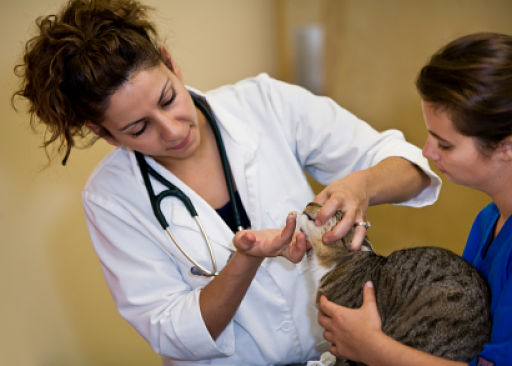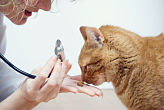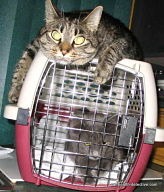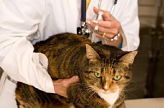Pilling a cat ...how to get the pill into your cat

Pilling a cat is serious business although I will end this section with a hilarious email I received a long time ago that actually told the scenario that most of us experience when trying to give a cat a pill. Unfortunately, how to give a cat a pill is not just for supplementing your cat’s diet with vitamins.
When your cat needs medications it is oftentimes when the poor cat is feeling ill and irritable. Your cat is also frightened when it sees you approaching with medications or just senses you are hiding something in your hand.
One method of pilling a cat is to grasp his head gently, but firmly, to tilt it back. If his mouth doesn’t drop open automatically, use a finger. Then try to pop the pill as far back as possible. Rubbing his throat will encourage him to swallow it…but remember that patience and calm behavior on your part will help your cat tolerate the stressful experience more easily. Follow up with a small amount of water to help ensure that the pill has gone down properly. I found this video on the internet that shows you how to do it. Pilling a Cat
Some cat owners struggle futilely to learn this technique, while others have cats that simply refuse to be pilled. And although some feline medications are available as a liquid, oral gel, transdermal gel or by injection, the pill is the most widely used formulation. If you consider camouflaging the medication in a bowl of food you encounter several problems.
The main problem with this approach is that some medications are better absorbed on a full stomach, while others are most effective if taken on an empty stomach so you have to have your vet specify when the meds should be given. Another problem you will discover rather quickly when you grind up the pills and mix them into his food…is that cats are not easy to fool.
Cats have very sensitive taste buds and a finicky feline will balk…and leave you with the uneaten dose. Moreover, once your cat has caught on to your hoax, he will likely double-check every future meal to make sure you haven’t snuck pharmaceuticals into it.
Another issue with the grind-and-mix method is that when a ground pill is mixed with food you don’t know if he has ingested the entire prescribed dosage if he doesn’t lick his plate clean. Plus, many pharmaceutical companies do not conduct tests to study the effectiveness of their medications when food is mixed with their product. Pilling a cat is challenging.
Also, pilling a cat involves some pills that are formulated with a coating that protects the active ingredients from digestive acids in the cat’s stomach. If this protective coating is destroyed through grinding, the active ingredient may be rendered inert by stomach acids, or may bond with food particles in the stomach before reaching the small intestine where it can be absorbed.
However, although the most widely used formulation for cat medications is the pill, (resulting in pilling a cat) certain meds are available as a liquid, oral gel, transdermal gel, or an injectable. A frequently prescribed antibiotic called amoxicillin is dispensed as a pink liquid, in a bottle with an eyedropper.
The instructions tell you to squirt the liquid into the cat’s mouth. Petroleum-based gels are available to treat hairballs and/or to soften stools. You squeeze the gel over the cat’s food, or onto his paws to be licked off.
A number of pharmaceutical products…including insecticides used for flea treatments…are available as transdermal gels. The gel is placed onto the cats’ skin in a difficult-to-lick location, and is absorbed through the skin. The gel can also be absorbed through your skin, so be sure to wash your hands after applying a transdermal gel medication.
Transdermal gels may be the simplest method of dosing, and if a medication that your cat needs regularly is not available in this form, you can have it custom made at a compounding pharmacy. However, again, there may not be sufficient data to back up the effectiveness of a drug delivered in gel form if that’s not the normal prescribed delivery method.
Pilling a cat can be challenging and after several unsuccessful attempts you might wonder why your vet can’t just five your cat a needle. Injections are no always a good idea. Medications given this way are an unpleasant experience for the cat, and not all medications are available by injection. With the exception of insulin injections for diabetes, the injection alternative is not a first choice, especially when you are dealing with long term and chronic conditions.
Injections can be dangerous when used for steroidal medications like cortisone, which is prescribed for inflammatory bowel disease and other allergy-related conditions. Some cats are very sensitive to these drugs. When given orally, the medication can be stopped immediately if a reaction occurs, but there is no way to stop the effects of the drug if administered by injection.
Sometimes there are alternative ways to treat the animal, for instance, cats with the chronic condition of hyperthyroidism are usually given Tapazole (methimazole), but they can be treated with surgery and radiation instead of medication.
Pilling a cat that is a pill-resistant cat but requires long-term medication for the management of a chronic problem such as a behavioral, heart, thyroid, intestinal or liver condition, then a compounding pharmacy might offer a solution. Compounding pharmacies work with a veterinarian and cat owner to compound a medication in a format that will be acceptable to the cat while remaining active and stable.
They might be able to compound your medication in a liquid format, and then cover the bad taste by flavoring it with shrimp, fish, liver or chicken. While this may prove to be an answer for many frustrated cat owners who have failed in their pilling a cat attempts, this service is not well suited to emergency or short-term prescription requirements.
Not all medications can be compounded at all, and others are not stable in a liquid state. Plus, since there is no data from testing by the manufacturers, the shelf life is unknown and can only be guessed at. Refrigeration will sometimes increase usability, but they cannot predict long term stability.
Compounded medications are custom designed and made by hand so they are always more costly but by the time some people get to this point, it is usually a last ditch effort, and they want to do what they can for their animal.
Things to Try:
- Establish a routine so that you are pilling a cat and giving medications according to the schedule prescribed by your veterinarian. Pilling a cat at the same time of day will help you to remember but the cat will also learn to anticipate the time and he might start hiding from you at that particular time. Try to give it at a time of day when the animal is most receptive. At mealtime, for example, most pets are underfoot or at least nearby. Tolerating a quick pilling might be worth the effort when the reward is a good meal.
- Avoid turning pill time into a contest of wills by offering affection and attention. If the cat is food-motivated, you can offer a treat afterwards, but not all cats will stick around for this. If your cats are like mine…the moment the pill is down the throat…they’re out of the room and under a bed or sofa.
- A resistant cat may be inclined to give up the struggle with a simple but firm reminder that you are not only his friend, but also his caretaker…and that you mean business. Place the cat on a table or counter, and stand over him so you are in a superior position. If necessary, wrap a towel around him to restrict movement to help your pilling a cat attempt.
- Like any creatures with a sense of taste, cats tend to turn up their noses at bad-tasting liquid medication. Refrigeration can often make an unpleasant taste more palatable. Before refrigerating a liquid medication check with your veterinarian to be sure that it is one that remains stable and effective when chilled. Preparations formulated with an oil base, for example, can become too thick at low temperature to flow through the dropper.
- Some owners find a pill gun, a small device that uses a plunger mechanism to “shoot” a pill into a cat’s mouth, an effective aid in administering medication...hence pilling a cat works.
When all else fails, consult with your veterinarian and a compounding pharmacy about pilling a cat. They might be able to customize a medication into a more easily administered form.
The Hilarious Episode of "How to Give a Cat a Pill" email
I had saved this email a few years ago because it was so funny. I do not endorse the crazy methods...do not try this at home...but this version of pilling a cat will give you a few laughs. If you know who wrote this, let me know and I will add their name.
How to Give a Cat a Pill (Pilling a Cat)
- Pick up cat and cradle it in the crook of your left arm as if holding a baby. Position right forefinger and thumb on either side of cat’s mouth and gently apply pressure to cheeks while holding pill in right hand. As cat opens mouth, pop pill into mouth. Allow cat to close mouth and swallow.
- Retrieve pill from floor and cat from behind sofa. Cradle cat in left arm and repeat process.
- Retrieve cat from bedroom, and throw soggy pill away.
- Take new pill from foil wrap, cradle cat in left arm, holding rear paws tightly with left hand. Force jaws open and push pill to back of mouth with right forefinger. Hold mouth shut for a count of ten.
- Retrieve pill from goldfish bowl and cat from top of wardrobe. Call spouse in from the garden.
- Kneel on floor with cat wedged firmly between knees, hold front and rear paws. Ignore low growls emitted by cat. Get spouse to hold head firmly with one hand while forcing wooden ruler into mouth. Drop pill down ruler and rub cat's throat vigorously.
- Retrieve cat from curtain rail. Get another pill from foil wrap. Make note to buy new ruler and repair curtains. Carefully sweep shattered figurines and vases from hearth and set to one side for gluing later.
- Wrap cat in large towel and get spouse to lie on cat with head just visible from below armpit. Put pill in end of drinking straw, force mouth open with pencil and blow down drinking straw. Check label to make sure pill not harmful to humans and drink one beer to take taste away. Apply Band-Aid to spouse's forearm and remove blood from carpet with cold water and soap.
- Retrieve cat from neighbor's shed. Get another pill. Open another beer. Place cat in cupboard, and close door onto neck, to leave head showing. Force mouth open with dessert spoon. Flick pill down throat with elastic band.
- Fetch screwdriver from garage and put cupboard door back on hinges. Drink beer. Fetch bottle of scotch. Pour shot, drink. Apply cold compress to cheek and check records for date of last tetanus shot. Apply whiskey compress to cheek to disinfect. Toss back another shot. Throw tee-shirt away and fetch new one from bedroom.
- Call fire department to retrieve the damn cat from the top of the tree across the road. Apologize to neighbor who crashed into fence while swerving to avoid cat. Take last pill from foil wrap.
- Using heavy-duty pruning gloves from shed, tie the little *&#%^'s front paws to rear paws with garden twine and bind tightly to leg of dining table. Push pill into mouth followed by large piece of filet steak. Be rough about it. Hold head vertically and pour two pints of water down throat to wash pill down.
- Consume remainder of scotch. Get spouse to drive you to the emergency room. Sit quietly while doctor stitches fingers and forearm and removes pill remnants from right eye. Call furniture shop on way home to order new table.
- Arrange for RSPCA to collect mutant cat from hell and call local pet shop to see if they have any hamsters.
- How To Give A Dog A Pill
- 1. Wrap it in chicken
- 2. Toss it in the air.
Related Articles......
Return from Pilling a Cat to Cat Health Homepage
Having trouble finding what you need? Cat Health Index & Site Map
OR
Do you have a question to ask?...Questions
OR
Do you have a cat story to share?...Simply click here to go to that page!
Copyright@2010-2020 All rights reserved.Cat-health-detective.com
This website is information only. Consult a veterinarian for medical assistance

"Like Us" on Facebook
or...
"Like Us" here




















